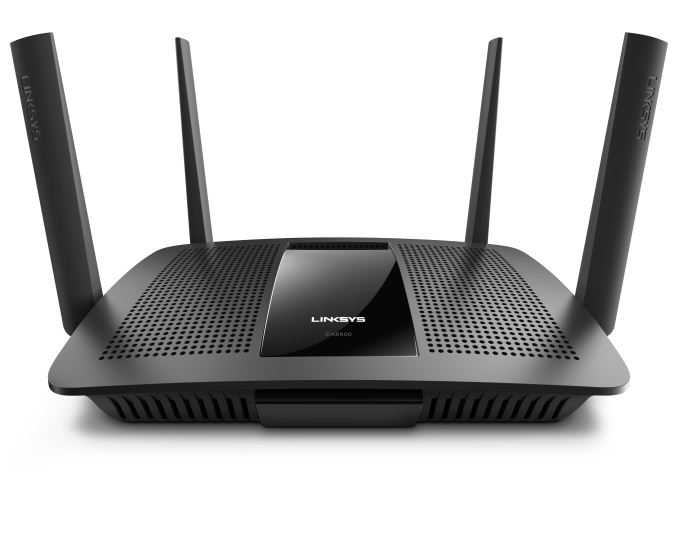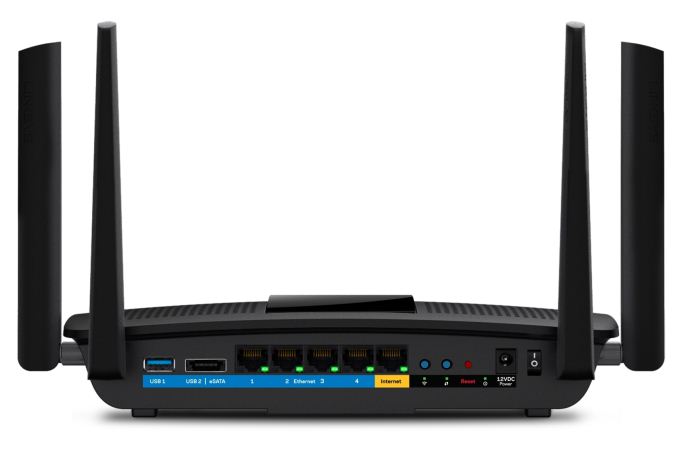Linksys EA8500 - First MU-MIMO Enabled 802.11ac Router Set to Ship
by Ganesh T S on May 7, 2015 7:00 AM EST- Posted in
- Networking
- Linksys
- 802.11ac
- Wi-Fi
- Qualcomm Atheros

Readers following our wireless networking coverage must be quite familiar with the developments in 802.11ac land. As a recap:
- The first 3-stream 802.11ac routers (based on the Broadcom BCM4706 chipset) started shipping in May 2012, with Buffalo Technologies and Netgear leading the way. There were marketed as AC1750 units (3x3 5 GHz providing up to 1300 Mbps and 3x3 2.4 GHz providing up to 450 Mbps). The street pricing of the AC1750 routers started to go down once Qualcomm started shipping their first-generation 802.11ac router platforms in products such as the TP-LINK Archer C7 in April 2013.
- In Q4 2013, a wave of AC1900 units started to hit the market. Netgear's Nighthawk R7000, a popular member in this series, still continues to sell well in the market. These units still used a 3x3 5 GHz radio for up to 1300 Mbps, but the 2.4 GHz had some proprietary Broadcom extensions (TurboQAM) to support up to 600 Mbps in an end-to-end Broadcom environment.
- In 2014, Quantenna began to bring their technology lead in the Wi-Fi space to the market with their Wave 2 4x4 802.11ac chipset. Despite being announced at CES 2014, the Asus RT-AC87U began to ship in July with the QSR1000 radio coupled with a Broadcom SoC. Netgear started to ship the same radio coupled with a Qualcomm IPQ8064 SoC in the Nighthawk X4 in September 2014. The QSR1000's Wave 2 feature set includes support for MU-MIMO, but neither of these routers shipped with MU-MIMO enabled in the firmware (citing lack of client support at that point of time). Given the 4x4 configuration, these routers were tagged as AC2350 / AC2400 units (600 Mbps in the 2.4 GHz band and 1733 Mbps in the 5 GHz band)
- In the midst of these Wave 2 product launches, Qualcomm announced plans for their Wave 2 802.11ac platforms (both routers and clients) in April 2014. Broadcom, being late to the Wave 2 party, decided to bring out the XStream platform with dual 5 GHz radios (six-stream configuration) also in April. They were able to get it quickly into the market too, with the Netgear Nighthawk X6 R8000 becoming available in June 2014.
- At CES 2015, we saw the first set of routers based on Qualcomm's QCA9880 4x4 Wave 2 802.11ac router platform getting announced. Vendors such as TP-LINK and TRENDnet were expecting their AC2600 class routers to ship towards the middle of the year.
Coming back to today's announcement regarding the EA8500, Linksys is becoming the first vendor to start shipping a QCA9980-based router. The important aspect here is that the router will ship with MU-MIMO enabled. Client devices with MU-MIMO enabled are also coming into the market just now (more on that in our detailed review). Hopefully, this announcement will spur both Netgear and Asus to enable MU-MIMO in the firmware for their Quantenna-based routers.
The salient features of the EA8500 router are listed below:
- 4x4 802.11ac with MU-MIMO and beamforming support
- QCA9980 radio + 1.4 GHz dual-core IPQ8064 SoC
- Simultaneous dual-band operation (5 GHz 802.11ac - 1733 Mbps, 5 GHz 802.11n - 600 Mbps, 2.4 GHz 802.11n - 800 Mbps)
- 1x USB 3.0, 1x USB 2.0 / eSATA
- 4x 1Gbps LAN, 1x 1Gbps WAN
- Adjustable antennas for optimal performance
One important point to note is that MU-MIMO capabilities will translate into real benefit only when there are multiple MU-MIMO-capable client devices talking to the router simultaneously. This will probably be a common scenario in enterprise Wi-Fi deployments soon. However, in a typical household, we would imagine that a situation involving multiple MU-MIMO clients is probably at least a good year away. Qualcomm is targeting an end-to-end play here, as the announcement made last year included a number of products in the client space with MU-MIMO capabilities.
Linksys is accepting pre-orders at $280 for the EA8500 today with shipments slated for May 10, 2015. Wide retail and e-tail availability is also expected starting next week. There is no doubt that MU-MIMO will be the most efficient way to boost Wi-Fi performance in the near future, and it is good that Linksys and Qualcomm are teaming together to accelerate its market adoption.
Source: Linksys











83 Comments
View All Comments
RichieHH - Thursday, May 7, 2015 - link
Oh please. OSS is just as vulnerable if not more so when people start shipping replumbed firmwares around.Flunk - Thursday, May 7, 2015 - link
It's better if your device manufacturer stopped supporting your device years ago like a lot of them have.Mr Perfect - Thursday, May 7, 2015 - link
True, but at least you can update open source routers regularly. My router received maybe five firmware updates from the manufacturer, then they came out with a newer high end model a year later and dropped mine like a rock. So now I've got a router that still fits my needs, but has a couple of known vulnerabilities in it. I'd rather not spend a couple hundred a year replacing routers that have nothing wrong with them but outdated firmware.arnd - Thursday, May 7, 2015 - link
Linksys E8350 and Netgear R7500 already use IPQ8064+QCA9880. Could it be that this new router is the first one with the new QCA9980 radio instead of QCA9880? That would make more sense with the 4x4:4 setup.ganeshts - Thursday, May 7, 2015 - link
Thanks for catching that typo - It is 9980. Btw, R7500 is QSR1000 from Quantenna (at least for the 5 GHz radio).Memo.Ray - Thursday, May 7, 2015 - link
USB 3.0 on the router? Did they solve the interference problem? I have a very bad experience using the USB 3.0 port causing a lot of interference: bad signal quality and continuously dropping connections.azazel1024 - Thursday, May 7, 2015 - link
The interference is very implementation specific. I have not been able to generate any noticable interference with my TP-Link Archer C8 with it's USB3 port with a couple of different USB3 devices. I have seen other's were even inactive USB3 devices connectioned to the router neutered 2.4GHz.Uplink10 - Thursday, May 7, 2015 - link
$280 for router with 1 Gbps WAN port, that means I can't max out my downlink and uplink if I have 1 Gbps Internet connection (1 Gbps down + 1 Gbps up). They should have included 10 Gbps WAN port.wtallis - Thursday, May 7, 2015 - link
Gigabit Ethernet is full-duplex, meaning it supports simultaneous transmit and receive at 1Gbps. You won't be held back by the Ethernet port.name99 - Thursday, May 7, 2015 - link
AND the 1733 rate is the PHY rate.The MAC rate is a half to two thirds that, depending on the precise aggregation capabilities that are implemented. Of all the things to whine about, this one is pretty low down the list.